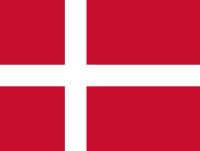 Denmark (ˈdɛnmɑrk/; Danish: Danmark, pronounced [ˈd̥ænmɑɡ̊], archaic: [ˈd̥anmɑːɡ̊]), officially the Kingdom of Denmark (Danish: Kongeriget Danmark) together with Greenland and the Faroe Islands, is a Scandinavian country in Northern Europe. It is the southernmost of the Nordic countries, southwest of Sweden and south of Norway, and bordered to the south by Germany. Denmark borders both the Baltic and the North Sea. The country consists of a large peninsula, Jutland (Jylland) and many islands, most notably Zealand (Sjælland), Funen (Fyn), Vendsyssel-Thy, Lolland, Falster and Bornholm, as well as hundreds of minor islands often referred to as the Danish Archipelago. Denmark has long controlled the approach to the Baltic Sea; before the digging of the Kiel Canal, water passage to the Baltic Sea was possible only through the three channels known as the “Danish straits.”
Denmark (ˈdɛnmɑrk/; Danish: Danmark, pronounced [ˈd̥ænmɑɡ̊], archaic: [ˈd̥anmɑːɡ̊]), officially the Kingdom of Denmark (Danish: Kongeriget Danmark) together with Greenland and the Faroe Islands, is a Scandinavian country in Northern Europe. It is the southernmost of the Nordic countries, southwest of Sweden and south of Norway, and bordered to the south by Germany. Denmark borders both the Baltic and the North Sea. The country consists of a large peninsula, Jutland (Jylland) and many islands, most notably Zealand (Sjælland), Funen (Fyn), Vendsyssel-Thy, Lolland, Falster and Bornholm, as well as hundreds of minor islands often referred to as the Danish Archipelago. Denmark has long controlled the approach to the Baltic Sea; before the digging of the Kiel Canal, water passage to the Baltic Sea was possible only through the three channels known as the “Danish straits.”
Denmark is a constitutional monarchy with a parliamentary system of government. Denmark has a state-level government and local governments in 98 municipalities. Denmark has been a member of the European Unionsince 1973, although it has not joined the Eurozone. Denmark is a founding member of NATO and the OECD. Denmark is also a member of the Organisation for Security and Cooperation in Europe (OSCE).
Denmark, with a mixed market capitalist economy and a large welfare state, ranks as having the world’s highest level of income equality. Denmark has the best business climate in the world, according to the U.S. business magazine Forbes. From 2006 to 2008, surveys ranked Denmark as “the happiest place in the world”, based on standards of health, welfare and education. The 2009 Global Peace Index survey ranks Denmark as the second most peaceful country in the world, after New Zealand. In 2009, Denmark was ranked as one of the least corrupt countries in the world according to the Corruption Perceptions Index, ranking second only to New Zealand.
The national language, Danish, is closely related to Swedish and Norwegian, with which it shares strong cultural and historical ties. 82% of the inhabitants of Denmark and 90.3% of the ethnic Danes are members of the Lutheran state church. As of 2010, 548,000 persons (9.9% of the Danish population) were either immigrants or descendants of recent immigrants. Most of these (54%) have their origins in Scandinavia or elsewhere in Europe, while the remainder originate mainly from Middle Eastern and African countries.
Denmark was inhabited by about 12,000 BCE. During the Viking period the Danes expanded their territory, and by the 11th century the Danish kingdom included parts of what are now Sweden, England, and Norway. Scandinavia was united under Danish rule from 1397 until 1523, when Sweden became independent; a series of debilitating wars with Sweden in the 17th century resulted in the Treaty of Copenhagen (1660), which established the modern Scandinavian frontiers. Denmark gained and lost various other territories, including Norway, in the 19th and 20th centuries; it went through three constitutions between 1849 and 1915 and was occupied by Nazi Germany in 1940 – 45.
A founding member of NATO (1949), Denmark adopted its current constitution in 1953. It became a member of theEuropean Economic Community in 1973 and of the European Union (EU) in 1993, but it negotiated exemptions from certain EU provisions in response to some Danes’ concerns regarding environmental protection and social welfare. In the early 21st century Denmark’s handling of immigrants raised great debate.
Hans Christian Andersen is known beyond Denmark for his fairy tales, such as The Emperor’s New Clothes, The Little Mermaid and The Ugly Duckling. Karen Blixen (pen name: Isak Dinesen), Nobel laureate author Henrik Pontoppidan, Nobel laureate physicist Niels Bohr, comedy pianist Victor Borge and philosopher Søren Kierkegaardhave also made a name for themselves outside Denmark.
Once essentially an agricultural country and still possessing a visibly rural landscape, Denmark after 1945 greatly expanded its industrial base so that by 2006 industry contributed about 25% of the gross domestic product and agriculture less than 2% (Denmark’s other traditional industries of fishing and shipbuilding have also declined). Financial and other services, trade, transportation, and communications are also important. The main commodities raised are livestock (pigs, cattle, and poultry), root crops (potatoes and sugar beets), and cereals (barley, wheat, and oats). There is a large fishing industry, and Denmark possesses a commercial shipping fleet of considerable size.
Notes from Wikipedia and Answers.com









